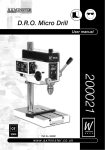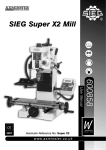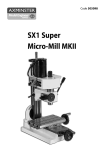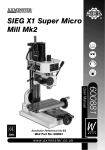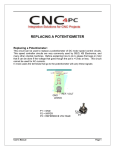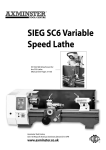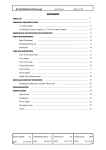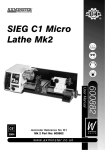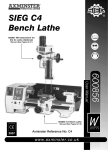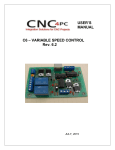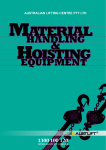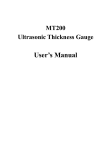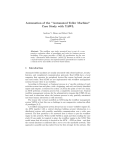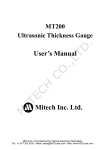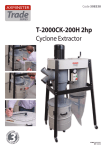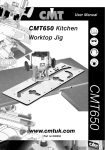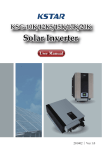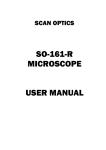Download User Manual Click to
Transcript
Code 505103 XN2 Super Tilt Head Mill Drill Index of Contents Page No Index of Contents 01 Declaration of Conformity 02 What’s Included 03 General Instructions for 230V Machines 04 Basic Safety for Machine Tools 05-06 Specifications 06 Definitions 07 Initial Assembly 07 Parts Description 08-09 Parts Illustration & Description 10-11-12 Operating Instructions 13-14-15 Collet Chuck Assembly (Optional) 16-17 Maintenance 17-18-19 Troubleshooting 20-21 Parts Breakdown Part 1,2,3 22-23-24 Parts List 25-26-27-28-29 Notes 30 symbols below advise that you follow the correct safety procedures when Warning The using this machine. Fully read manual and safety instructions before use Eye protection should be worn Ear protection should be worn 01 Foot protection should be worn Declaration of Conformity Copied from CE Certificate The undersigned, authorised by Shanghai SIEG Machinery Co., Ltd. No.555 Caofeng Rd. South to No.17 Bridge of Caoan Rd. Shanghai, P.R. China declares that this product: MILLING MACHINE XN2 manufactured by Shanghai SIEG Machinery Co. is in compliance with the following standards or standardisation documents in accordance with Council Directives EN 61029-2-5: 2002 EN 61029-1:2000+A11:2003+A12:2003 EN 55014-1:1993+A1:97+A2:99 EN 55014-2:1997 EN 61000-3-2:2000 EN 61000-3-3:1995/+A1:2001 02 What’s Included Model Number 1 No. 1 No. 1 No. 1 No. 1 No. 1 No. 1 No. 1 No. 2 No. 1 No. 1 No. 1 No. 1 No. A B C D E F G H I XN2 SIEG Super X2 Mill with (1-13mm Chuck & B16 Taper) Chuck Key Tommy Bar Morse Taper Drift Oil Can 8 x 10mm Double End Spanner 12 x 14mm Double End Spanner 3,4,5,6mm Hex Keys ‘T’ Slot Keepers Position Key Spare Fuse Guarantee Card Instruction Manual E D F B A I G C H ! Please read the Instruction Manual prior to using your new machine; as well as the installation procedure, there are daily and periodic maintenance recommendations to help you keep your machine on top line and prolong its life. Keep this Instruction Manual readily accessible for any others who may also be required to use the machine. Having unpacked your machine and its accessories, please check the contents against the equipment list "What’s Included", if there are any discrepancies, please contact Axminster Tool Centre using the procedures laid down in the catalogue. Please dispose of the packaging responsibly, much of the material is bio-degradable. The machine and its accessories will arrive coated with heavy corrosion preventative grease. This will need to be cleaned from the machine, its components and accessories prior to it being set up and commissioned. Use coal oil, paraffin or a proprietary degreaser to remove the barrier grease. Be warned, it will stain if you splash it on clothing etc., wear overalls, coverall et al., rubber gloves are also a good idea, as is eye protection if your cleaning process tends to be a little bit enthusiastic. After cleaning, lightly coat the exposed metal surfaces of the machine with a thin layer of light machine oil. N.B If you used paraffin/kerosene make sure you apply this thin film sooner rather than later. 03 General Instructions for 230V Machines Good Working Practices/Safety The following suggestions will enable you to observe good working practices, keep yourself and fellow workers safe and maintain your tools and equipment in good working order. ! WARNING!! KEEP TOOLS AND EQUIPMENT OUT OF THE REACH OF YOUNG CHILDREN Mains Powered Tools Primary Precautions These machines are supplied with a moulded 13 Amp. plug and 3 core power cable. Before using the machine inspect the cable and the plug to make sure that neither are damaged. If any damage is visible have the damaged item inspected/repaired by a suitably qualified person. If it is necessary to replace the plug, it is preferable to use an ‘unbreakable’ type that will resist damage on site. Only use a 13 Amp plug, and make sure the cable clamp is tightened securely. Fuse as required. If extension leads are to be used, carry out the same safety checks on them, and ensure that they are correctly rated to safely supply the current that is required for your machine. Work Place/Environment The machine is not designed for sub-aqua operation, do not use when or where it is liable to get wet. If the machine is to be used outside and it starts to rain, stop work and move it inside. If machine has got wet; dry it off as soon as possible, with a cloth or paper towel. Do not use 230V a.c. powered machines anywhere within a site area that is flooded or puddled, and do not trail extension cables across wet areas. Keep the machine clean; it will enable you to more easily see any damage that may have occurred. Clean the machine with a damp soapy cloth if needs be, do not use any solvents or cleaners, as these may cause damage to any plastic parts or to the electrical components. Keep the work area as uncluttered as is practical, this includes personnel as well as material. ! (Under no circumstances should CHILDREN be allowed in work areas) It is good practice to leave the machine unplugged until work is about to commence, also make sure to unplug the machine when it is not in use, or unattended. Always disconnect by pulling on the plug body and not the cable. Once you are ready to commence work, remove any tools used in the setting operations (if any) and place safely out of the way. Re-connect the machine. Carry out a final check e.g. check the cutting tool, drill bit, saw blade etc., is securely tightened in the machine, check you have the correct speed and function set, check that the power cable will not ‘snag’ etc. Make sure you are comfortable before you start work, balanced, not reaching etc. If the work you are carrying out is liable to generate flying grit, dust or chips, wear the appropriate safety clothing, goggles, gloves, masks etc., If the work operation appears to be excessively noisy, wear ear-defenders. If you wear your hair in a long style, wearing a cap, safety helmet, hairnet, even a sweatband, will minimise the possibility of your hair being caught up in the rotating parts of the machine, likewise, consideration should be given to the removal of rings and wristwatches, if these are liable to be a ‘snag’ hazard. Consideration should also be given to non-slip footwear, etc. DO NOT work with cutting or boring tools of any description if you are tired, your attention is wandering or you are being subjected to distraction. A deep cut, a lost fingertip or worse; is not worth it! DO NOT use this machine within the designated safety areas of flammable liquid stores or in areas where there may be volatile gases. There are very expensive, very specialised machines for working in these areas, THIS IS NOT ONE OF THEM. Check that cutters, drills, blades etc., are the correct type and size, are undamaged and are kept clean and sharp, this will maintain their operating performance and lessen the loading on the machine. Above all, OBSERVE…. make sure you know what is happening around you, and USE YOUR COMMON SENSE. 04 Basic Safety for Machine Tools KNOW YOUR MACHINE TOOL Read and understand the owner's manual and labels affixed to the tool. Learn its application and limitations as well as specific potential hazards peculiar to the tool. KEEP GUARDS IN PLACE Keep all guards in place. They are there for your protection and do not interfere with the correct operation of your machine. REMOVE ADJUSTING KEYS AND WRENCHES Form the habit of checking to see that keys and adjusting wrenches are removed from the machine before turning it on. KEEP WORK AREA CLEAN Cluttered areas and benches invite accidents. Floors must not be slippery due to liquids or dust. Make sure you clean up any waste materials on completion of work. AVOID DANGEROUS ENVIRONMENTS Do not use power tools in damp or wet locations or expose them to rain. Keep work area well lit. Provide adequate space surrounding the work area. KEEP CHILDREN AWAY FROM WORK AREA UNLESS UNDER CLOSE SUPERVISION All visitors should be kept a safe distance from work area. Children are naturally curious; therefore ensure they are closely supervised when they are near the work area. MAKE WORKSHOP TAMPER PROOF Many machines have lockable switches that can be secured with a small padlock or have a removable key. Please make use of them to prevent unauthorised operation of your machines. DO NOT FORCE TOOL It will do the job better and safer at the rate for which it was designed. Develop a patient approach to the work, you will get better results in the finished product. WEAR PROPER CLOTHING Do not wear loose clothing, gloves, neckties or jewellery that can catch in moving parts of machinery. Non-slip footwear with steel toecaps is recommended. Wear protective hair covering to contain long hair. Roll up long sleeves to above the elbow. SECURE WORK Where applicable use clamps or a vice to hold work. This leaves both hands free to operate the tool correctly and thus produces better results. DIRECTION OF FEED Feed work into a blade or cutter against the direction of rotation of the blade or cutter only. This will reduce the danger of kick back which is a serious hazard. Similarly, when using a lathe, feed the cutting edge of the tool against the direction of rotation! USE SAFETY GOGGLES AND FACE PROTECTION Wear safety goggles (complying to relevant standards) at all times. Normal spectacles only have impact resistant lenses and are NOT sufficient. Also use face or dust masks if the cutting operation is dusty (connection of machine to a dust extractor is preferred). Always wear ear defenders for cutting, sawing, planing or routing operations. Your hearing can be permanently damaged if exposed to high noise levels for long periods of time. DO NOT OVERREACH Keep proper footing and balance at all times. MAINTAIN TOOL WITH CARE Keep tools sharp and clean at all times for the best and safest performance. Follow the manufacturer's instructions for lubricating and sharpening and also for changing accessories. DISCONNECT POWER FROM THE TOOL Before servicing or when changing accessories always disconnect the power supply to avoid accidental starting. AVOID ACCIDENTAL START UP Although most machines are now equipped with NVR switches, develop the habit of making sure the switch is in the "OFF" position before connecting the machine to the power supply. 05 Basic Safety for Machine Tools USE RECOMMENDED ACCESSORIES Consult the owner's manual for details of any manufacturer's accessories or contact your supplier for details of recommended accessories. Follow the instructions that accompany the accessory. The improper use of accessories may cause hazards. The fitting of non-recommended accessories may also cause hazards. CHECK DAMAGED PARTS Before using the tool, a guard or other part that is damaged should be carefully checked to ensure that it will operate properly and perform its intended function. Check for alignment of moving parts, breakage of parts, mounting and any other conditions that may affect its operation. A guard or other part that is damaged should be properly repaired or replaced. A parts list is to be found at the back of your operator's manual. NEVER LEAVE A MACHINE RUNNING UNATTENDED ALWAYS turn power off. Do not leave machine until it comes to a complete stop. DRUGS, ALCOHOL AND MEDICATION NEVER operate tools whilst under the influence of drugs, alcohol or after taking medication. USE THE CORRECT TOOL Do not force a tool or attachment to do a job for which it was not designed. This is dangerous workshop practice. Specification Code 505103 Power 230V 50Hz 500W Drilling Capacity (ST 37) 13mm/M8 Face Milling Capacity 30mm End Milling Capacity 16mm Throat 160mm Distance between Spindle/Table 320mm Thread Pitch of Lead Screw 2mm Lead Screw Diameter M14 Spindle Taper MT-2 / M10 Spindle Speed (Variable) 50-2500rpm Speed Ratio 1:2 Spindle Stroke 60mm Column Tilting Range 45˚Left / 30˚ Right Max. Table Stroke x-axis 250mm Max. Table Stroke y-axis 160mm Max. Table Stroke k-axis 300mm Max. Tapping Size (HT200) M8 Max. Tapping Size (45) M6 Max. Milling Diameter ø30mm Table Size 130 x 500mm Overall Size: (LxWxH) 610 x 610 x 780mm Weight 127kg 06 Definitions ‘X’ Axis. This is the axis described by the work table as it is moved side to side. Normally, movement that moves the tool to the right in the workpiece is referred to as +ve ‘X’, and movement that moves the tool to the left in the workpiece is referred to as –ve ‘X’. Where the initial position of the tooling and the worktable is designated 0,0. (Horizontal plane only). ‘Y’ Axis. This is the axis described by the work table as it is moved from front to back. (Traverse) Normally movement that moves the tool to the front in the workpiece is referred to as-ve ‘Y’, and movement that moves the tool to the rear in the workpiece is referred to as+ve ‘Y’. Where the initial position of the tooling and the worktable is designated 0,0.(Horizontal plane only). ‘Z’ Axis This is the axis described by the worktable in the vertical plane. (Not possible with this machine). However, to establish a point in space, the co-ordinates can be transferred to the ‘tip’ of the tooling, whereby, if we assume that the tool and the worktable in their initial positions, where designated 0,0,0, (Horizontal and vertical planes) any point above the tool tip is referred to as +ve ‘Z’, and any point below the tool tip is referred to as -ve ‘Z’ Initial Assembly Ideally, your mill should be installed close to a correctly rated power supply, in a warm dry environment, well ventilated and illuminated by bright clear natural light, with adequate access all around the machine, and sufficient adjacent storage space for your tools, accessories and material. The Mill is best mounted on a rigid bed; this is to ensure stability of the machine and to attenuate any vibration that is generated when the machine is running. The bed should be flat and set level in both planes, and at a height that enables comfortable operation of the machine. It is not necessary to anchor the bed through to the floor, but it must be stable enough to remain immovable during any normal forceful operations (especially tightening) carried out whilst operating your mill. If you are preparing your own bed for the machine, it should be at least 552mm long by 390mm wide; (to cover the footprint of the base (506 x 352), you will need to drill 4 No. 10mm holes to allow for bolt fixing. (See Fig A) Fig A Locate and identify the 3 rod handles from the packing box. Fit these to the 3 wheel handles, (Work table control, traverse feed control, head raise and lower control.) 506mm Bolt the mill to the bed using M10 nuts,caphead bolts and washers. Machine Base 10mm Hole 352mm 07 Parts Description Base casting This is the stand for the milling m/c. It is a square casting with a seated flange to the rear, which mounts the main tool post. There are four holes to each corner to be bolted to a bench or stand. There is a dovetail slide machined to the front service of the base, to mount the traverse slide of the work table. Main tool post This is the column of the mill, with a dovetail slide machined on the front which the milling head is mounted. Rise & fall drive screw The rise and fall is anchored in a machined housing at the top of the tool post. It has a wheel with a graduated ring (thimble), so the movement of the slide can be measured. The wheel is connected to a rod shaft that enable the screw to be turned, allowing the head to move up and down. Turning the handle clockwise will raise the head and anti-clockwise to lower it. Tilt housing assembly The tilt housing is a turntable which is integrated in the milling head. Mounted on top of the tool post is a threaded locking pin that locks the head at 90˚ degrees (See fig 3), turning the 10mm nut (clockwise) will drive the pin up thus unlocking the head. On either side of the head there are two rounded nuts that clamp the tilt assembly in position. Loosening the nuts will allow the head to pivot + 45˚ or - 45˚ degrees, using the scale and pointer on the right hand side of tilt housing. (See figs 1 & 7) Traverse slide The traverse slide casting mounts onto the dovetail slide of the base casting. There is a gybe strip fitted to the left side dovetail to maintain the fit. In the front face of the slide is a machined housing which mounts and anchors the drive shaft for the traverse feed. Under the slide (on the base) is a threaded dog mounted in a fixed position, through which the traverse drive shaft is threaded so as to enable the slide to be driven back and forth. The top of the traverse slide has a female dovetail machined into it, perpendicular to the lower dovetail. This marries with the dovetail on the underside of the worktable. The front face of the dovetail is fitted with a gybe strip to maintain the fit. The top of the slide also has a fixed threaded dog mounted to it, through which the drive shaft of the worktable is threaded to allow the worktable to be driven from side to side. In between the grubscrews and locknuts of the gybe strip adjustor is M4 caphead bolt handles that can be driven forward to clamp the gybe strips against the dovetails to enable the traverse and longitudinal movements to be locked in position. Traverse slide control The traverse slide is driven using the wheel and rod handle at the front of the machine. Behind the boss of the handle is a graduated ring (thimble) so that the movement of the slide can be measured. The thimble is held to the drive shaft by friction, and can be pre-positioned to a predetermined start or stop dimension. Work table The worktable is a machined casting 500mm long by 130mm wide. There is a dovetail section machined in the underside to mate with the traverse slide. There are 4 x 16mm open ended ‘T’ slots machined in the table along its length, to facilitate the fixing of machine vices or clamps. The worktable is mounted onto the traverse slide. The right end face of the worktable has a housing machined in it to mount and anchor the drive shaft assembly. Work table control The Worktable slide is driven using the wheel and rod handle at each end of the table. Behind the boss of the handle is a graduated ring (thimble) so that the movement of the worktable can be measured. The thimble is held to the drive shaft by friction, and can be pre-positioned to establish a predetermined start or stop dimension. 08 Parts Description Milling head This is the ‘milling machine’ and the descriptions of its various parts and components are detailed as follows:- Milling head casting The main casting to which all the components are attached. The head has a dovetail housing machined at the rear, which allows the casting to be fitted to the Main Tool Post. The left side of the dovetail slide is fitted with a gybe strip to maintain the fit. Head clamp Similar to the traverse and longitudinal slides, centrally located between the gybe strip adjusters and locknuts there are two M4 bristol handled bolts that clamp the gybe strip against the slide to effect a locking action for the rise and fall of the head. Motor & gearbox the gearbox assembly is mounted inside the head box casting. The motor drive is geared through to the spindle. Tri-lever handle Three levered handle that is used to drive the quill (and hence the chuck or the tool) up and down. The boss of the handle is fitted to the end of a ‘splinted’ gear shaft. This ‘splinted’ gear is, in turn, engaged in the rack cut into the quill body. The other end of the ‘splinted’ shaft is engaged in a contra-wound spring, this provides counter balance to the weight of the quill, arbor, chuck and drill, giving a more controlled ‘feel' during drilling operations. It also retracts the quill when drilling is completed. Draw bar cover A steel threaded cover that screws into the top of the Motor Gearbox assembly, to afford protection from the rotating top of the draw bar, when the quill is at the top of its travel. Draw bar (unseen) This is a metal rod, threaded M10 at one end and with an 8mm squared shank and flange machined on the other. It is fitted through the spindle mandrel to hold the fitted tool/tooling hard into the No2 MT taper of the spindle shaft. Motor 230V d.c. motor rated at 500W. 09 Parts Illustration & Description Tilt housing Draw bar Typ. 3 Spindle automatic return button Scale Tri-lever feed handle Fine feed control knob (see page 14) D.R.O control (see page 13) Fine feed clutch knob Guard Pointer Fig 1 Control panel (see page 12) Work table Chuck Machine base ‘T’ Slot Drip cover Traverse slide control handle Work table drive handle Positive stop plate Typ. 2 Adjustable stop Gibs strip adjusters Worktable thimble 10 Longitudinal feed clamp Parts Illustration & Description Rise and fall handle Typ.2 Rise and fall clamps Typ. 6 Rise and fall gib strip adjusters Tool post Fig 2 Spindle lock handle Tool tray Main tool post Traverse slide clamps Traverse slide thimble Traverse slide gib strip adjusters 11 Parts Illustration & Description 10mm nut Rise & fall thimble Fig 3 90˚ Locking pin assembly Traverse slide stop Tilt housing clamps, two on each side of the milling head. -45˚ +45˚ Fig 4 Tilt housing assembly 12 Operating Instructions Control Panel 1. Make sure the correct fuse is in the fuse box and the power switch is off. Unlock the emergency stop button, connect the machine to mains and switch on. The power light on the control panel will come on. 2. When the machine is on, press the (start) button, the motor starts up. Press the button ( increase the speed, while pressing ( forward rotation, while ( ) will decrease the speed. Press the ( ) to ) to control the ) controls the backward rotation. Pressing the (TAPPING) button, will slow down the spindle’s rotation to 0-500rpm, as above, and the word TAPPING will appear on the controls display. The switches on the handles control the spindles rotation, forward and reverse. Pressing the (STOP) button, will stop the machine. Note: The circuit boards on the machine has an overload protection function. If the material you are drilling or milling is over excessive volume, it will cause the machine to automatically stop and will display an error message on the LCD, on the control panel. Remove the material from the machine, reset the machine by switching the power switch on/off and continue with operation. 5 1 9 6 11 2 7 Parts Identification 1. Power Light 2. Fuse 3 3. Emergency Stop Button 4. Control Panel 5. LCD Display 6. Power Switch 13 7. Speed increase Button 8. Speed Decrease Button 9. Forward Rotation Button 10. Backward Rotation Button 8 11. Tapping Button 12. Start Button 4 10 13. Stop Button 13 12 Operating Instructions D.R.O. Control Digital Read Out (DRO) (Fig 5) For normal drilling operations press the ON/OFF switch first, and then press the “ZERO” button. Press “mm/in” button to select metric or imperial readings. These two buttons can be effected regardless of the down feed handle position, then you can start drilling. The readings on the display can be amended at any time by pressing “plus” or “minus” buttons. When displaying error (e.g. no readings or flashing) it means the batteries are low and need replacing. Push against the arrow showing in (Figs 5a & 5b) to open the battery cover, withdraw the battery for replacement. The voltage of the Zinc button batteries is 1.2 volts. After replacement, re-fit the cover. Fig 5 Min/in Digital display Press “mm/in” button to select metric or imperial readings. Plus & Minus On/Off The readings on the display can be amended at any time by pressing “plus” or “minus” buttons. For normal drilling operations press the ON/OFF switch first, and then press the “ZERO” button. Fig 5b Fig 5a Removing battery cover 1.2 volt zinc button battery 14 Operating Instructions Engaging the fine feed control 1) Turn the fine feed clutch knob clockwise until it becomes tight (DO NOT OVERTIGHTEN), thus engaging the fine feed control mechanism (See fig 6). 2) Turn the fine feed control knob to lower or raise the spindle in gradual movements (See fig 7). 3) To disengage the fine feed control turn the clutch knob anti-clockwise until it is loose. Fine feed control knob Engage Fig 6 Disengage Turn the clutch knob clockwise to engage the fine feed control,turning the knob anti-clockwise will disengage it. Fine feed clutch knob Fig 7 Turn the fine feed control knob to lower or raise the spindle in slow succession 15 Collet Chuck Assembly (Optional) The chuck can be removed and replaced with an optional collet chuck for milling operations. Please follow the instruction below for chuck removal. ! DISCONNECT THE MACHINE FROM THE MAINS SUPPLY 1) Unscrew the draw bar cover and safely put to one side (See fig 8). Turn the spindle lock handle clockwise to lock the spindle. (See page 11) Blind pocket Draw bar cover Arbor Hex key recess Fig 8 Tommy bar Spindle Fig 9 2) Open the chuck guard, locate a 8mm hex key and the tommy bar. Insert the tommy bar into the blind pocket’s recess in the spindle (See fig 9), insert the 8mm hex key into the top of the arbor, as shown in figs 8 & 10. 3) While holding the tommy bar rotate the hex key anticlockwise (one turn) until part of the arbor is showing (See fig 10) Arbor Fig 10 Hex key Brass/wood hammer Fig 11 Fig 12 13mm chuck B16 taper 4) Remove the hex key and tommy bar, support the chuck with one hand and using a brass or wooden hammer strike the arbor to release the chuck taper from the spindle taper. Unscrew the chuck from the arbor and remove. (See figs 11 & 12) 16 Collet Chuck Assembly (Optional) Fig 13 4) Insert the collet chuck into the spindle taper and screw it onto the arbor shaft. Hold the collet chuck, using an adjustable or ‘C’ spanner (See fig 13). Insert the 8mm hex key into the recess on top of the arbor as shown in figs 8 & 10, while holding the chuck tighten the arbor (DO NOT OVERTIGHTEN) 5) Replace the draw bar cover, release the spindle lock handle, reconnect the mill to the mains and continue with the operation. Collet chuck “C” or adjustable Spanner Maintenance Oiling Points Fig 14 Oil OIL 17 Maintenance Worktable and Traverse feed adjustment The worktable and the traverse feed are both mounted over dovetail sections. In order to maintain the ‘tightness’ of the fit; between the sloping surface of the component and its mating surface a gybe strip has been inserted. (At the front of the worktable, and to the left hand side of the traverse feed). To adjust the gybe strips, use a 8mm spanner and a flat ended screwdriver, release the lock nuts and screw the gybe strip grubscrews clockwise to compensate for any slackness or anti-clockwise to loosen the movement. Check, using the feed handles, that worktable and the traverse feed moves smoothly, If not, repeat the adjustments until the movement is smooth and tight over the whole of the travel. (See figs 15 & 16) 8mm spanner Fig 16 Gybe strip Fig 15 Screwdriver Milling Head adjustment The Milling Head is mounted over a dovetail section. In order to maintain the ‘tightness’ of the fit; between the sloping surface of the component and its mating surface, on the left hand side, a gybe strip has been inserted. To adjust the gybe strips, use the supplied 8mm spanner, release the lock nuts and screw the gybe strip grubscrews clockwise to compensate for any slackness or anti-clockwise to loosen the movement. Check, using the rise and fall drive feed handle, that the head moves smoothly, If not, repeat the adjustments until the movement is smooth and tight over the whole of the travel. (See fig 17) Rise & fall handle Mill head gybe strip adjusters Fig 17 18 Maintenance Your Mill is a precision tool. In order to maintain this precision and prolong its useful life, it is advised that you follow the recommended daily and periodic maintenance tables printed below. Daily and Periodic Maintenance Daily 1. Carry out a visual inspection. Repair any damage immediately. Minor damage to the beds should be taken out with an oilstone. 2. Move the worktable and the traverse feed back and forth by hand, check that the movement is smooth. 3. Spread a light film of oil over the worktable and the traverse slide bed. 4. Oil the end bearings of the drive shafts. Squirt oil onto the slide faces of mating components. Exercise the components to ensure the oil is spread over both visible and obscure surfaces. Daily after-use 1. Clean all swarf and chips away from the machine bed, slide surfaces, and the tool post. 2. Exercise the slides and ensure no swarf etc., is lodged in the drive shaft tunnels. If you have been using a coolant make sure the machine is thoroughly dried off. 3. Check the tool, ensure it is usable the next time, if not re-sharpen or replace the tool tip. 4. Lightly oil spray all the machine beds and surfaces. 5. Clean and lightly oil any tools you may have been using (drill chucks, spanners, chuck keys etc), and put them away. 6. Switch off the power supply. Disconnect the plug. 7. Cover the machine over with a dust cloth. Weekly 1. Move the traverse slide fully back to give access to the tunnel, blow out to make sure all swarf is cleared away and heavily spray oil the tunnel, exercise the slide to work the oil into the drive thread and to lubricate the dog. 2. Spray oil the slide and the worktable bed, exercise the worktable to spread the oil to all surfaces, both hidden and visible. 3. Spray oil the underside of the machine onto the drive screws, exercise to ensure the oil is coating all components. 4. Clean and spray oil the rise and fall drive screw, exercise to ensure all parts are coated. 5. Check the movement of the worktable, the traverse slide and the head, check they are smooth and ‘tight’, if necessary reset the gybe strips until the movements are smooth and tight. 6. Wipe the quill outer sleeve clean and lightly oil, exercise the quill to spread the oil in the sleeve bushes. Monthly a) Give the motor a good ‘blow through’ to remove any dust, dirt etc. b) Check all the interlocks function correctly. Accessories There are numerous accessories for the machine listed in the Axminster catalogue. 19 Troubleshooting 20 Troubleshooting 21 Parts Breakdown Part 1 22 Parts Breakdown Part 2 23 Parts Breakdown Part 3 24 Parts List 25 Parts List 26 Parts List 27 Parts List 28 Parts List 29 Notes 30 Please dispose of packaging for the product in a responsible manner. It is suitable for recycling. Help to protect the environment, take the packaging to the local recycling centre and place into the appropriate recycling bin. Only for EU countries Do not dispose of electric tools together with household waste material. In observance of European Directive 2002/96/EC on waste electrical and electronic equipment and its implementation in accordance with national law, electric tools that have reached the end of their life must be collected separately and returned to an environmentally compatible recycling facility. Axminster Tool Centre, Unit 10 Weycroft Avenue, Axminster, Devon EX13 5PH axminster.co.uk
































